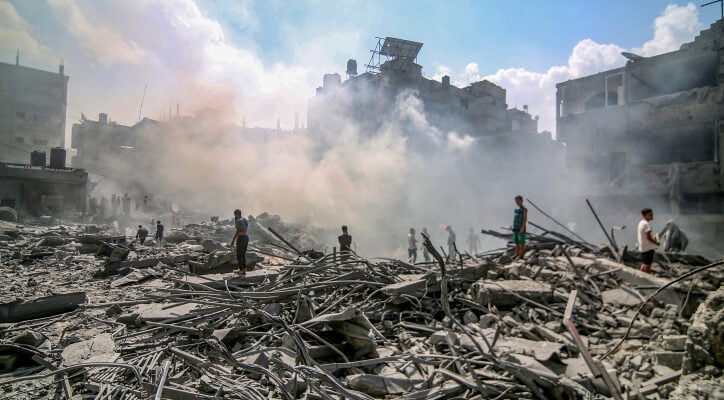Gaza has been under an almost complete communications blackout since Friday evening.
By Reuters and Algemeiner Staff
Gaza was largely cut off from the outside world on Saturday as Israel rained more bombs from the air and suggested its long-promised ground offensive against Hamas terrorists controlling the Palestinian enclave was underway.
Israel said troops sent in on Friday night were still in the field whereas previously it had made only brief sorties during three weeks of bombing to destroy Hamas who killed 1,400 Israelis, mostly civilians, on Oct. 7.
“We attacked above the ground and under ground, we attacked terror operatives of all ranks, everywhere,” Defence Minister Yoav Gallant said in a video statement.
“The operation will continue until a new order.”
Israel’s military renewed a call for civilians to move south from the north where it says Hamas is hiding under civilian buildings. Palestinians say nowhere is safe.
Gaza has been under an almost complete communications blackout since Friday evening, which the Palestinian Red Crescent blamed on Israel.
Military spokesperson Daniel Hagari said Israel would allow trucks with food, water and medicine to enter Gaza, indicating that bombing might pause, at least in the area of its border with Egypt where some aid has trickled in.
Aid agencies say a humanitarian catastrophe is unfolding for Gaza’s 2.3 million people who are under a total Israeli blockade.
The head of the World Health Organisation (WHO), Tedros Adhanom Ghebreyesus, said the blackout was blocking ambulances and evacuations of patients and denying people safe shelter.
He and other aid agencies said they could not contact their staff, but a representative from the International Committees of the Red Cross (ICRC) and Red Crescent in Gaza got an audio message out.
William Schomburg said medics were working around the clock while also dealing with personal tragedies. “I spoke to one doctor who had lost his brother and cousin the night before,” he told the BBC in a clip the ICRC posted on X.
The few journalists who made contact with the outside world also said the situation was the worst it had been.
“If you are dying, you can’t ring up the ambulance service. If you are struck, whatever happens, you can’t communicate with anyone,” Plestia Alaqad said in a video.
Drones and planes buzzed in the background.
“There is no internet, no network, no service, no fuel to move around by car, no electricity, nothing,” she added.
Video from the Israeli side of the heavily-fortified fence on Saturday morning showed explosions sending up clouds of smoke among a line of ruined buildings.
Al Jazeera, which broadcast live satellite TV footage overnight showing frequent blasts in Gaza, said Israeli air strikes had hit areas around the enclave’s main hospital, Al Shifa, in Gaza City in the north.
Israel’s military accused Hamas on Friday of using the hospital as a shield for its tunnels and operational centers, an allegation the group denied.
Reuters could not verify reports of strikes near the hospital.
Some of the relatives of people captured in Israel during the Oct. 7 Hamas assault demanded a meeting with the Israeli government after what they called “the most terrible of all nights”.
“None of the war cabinet bothered to meet with the families of the hostages to explain one thing – whether the ground operation endangers the well-being of the 229 hostages in Gaza,” the Hostages and Missing Persons Families Forum headquarters said.
Gallant said he would meet with family representatives of the hostages on Sunday.
Another relative of hostages, Yosi Shnaider, said Israel’s military operation was the only way to release them.
“We can’t wait anymore,” he said.
Israel said rockets were still being fired at it from Gaza and released footage of its ground forces, including a column of tanks, operating inside the territory, though it did not specify when it was from.
Fighter jets killed the head of Hamas’ aerial wing, Asem Abu Rakaba, a key figure in the Oct. 7 attack on Israel’s southern towns, it said.
“He directed the terrorists who infiltrated Israel on para-gliders and was responsible for the drone attacks on IDF (Israel Defense Forces) posts,” the military said.
Fighter jets had also struck 150 underground targets in the northern Gaza Strip, including Hamas tunnels, underground combat spaces and other underground infrastructure, killing others from the group.
The armed wing of Hamas, the al-Qassam brigades, said early on Saturday its fighters were clashing with Israeli troops in Gaza’s northeastern town of Beit Hanoun and in the central area of Al-Bureij.
“Al-Qassam Brigades and all Palestinian resistance forces are fully prepared to confront the aggression with full force and thwart the incursions,” it said.
The United States and other Western countries have offered strong support to Israel but urged it to hold off on a ground offensive for fear of high casualties among Palestinians and a widening conflict.
Hamas is backed by Iran, which also supports militias in Lebanon, Syria, Iraq and Yemen. U.S. troops have come under fire from Iran-backed groups in Iraq and Syria. Washington has been moving more military assets to the region.
The Israeli military reported a new exchange of fire on the border with Lebanon on Saturday, the latest in what have been the most serious clashes on the border since 2006. Israel’s neighbor Egypt said drones fell on the country on Friday.




